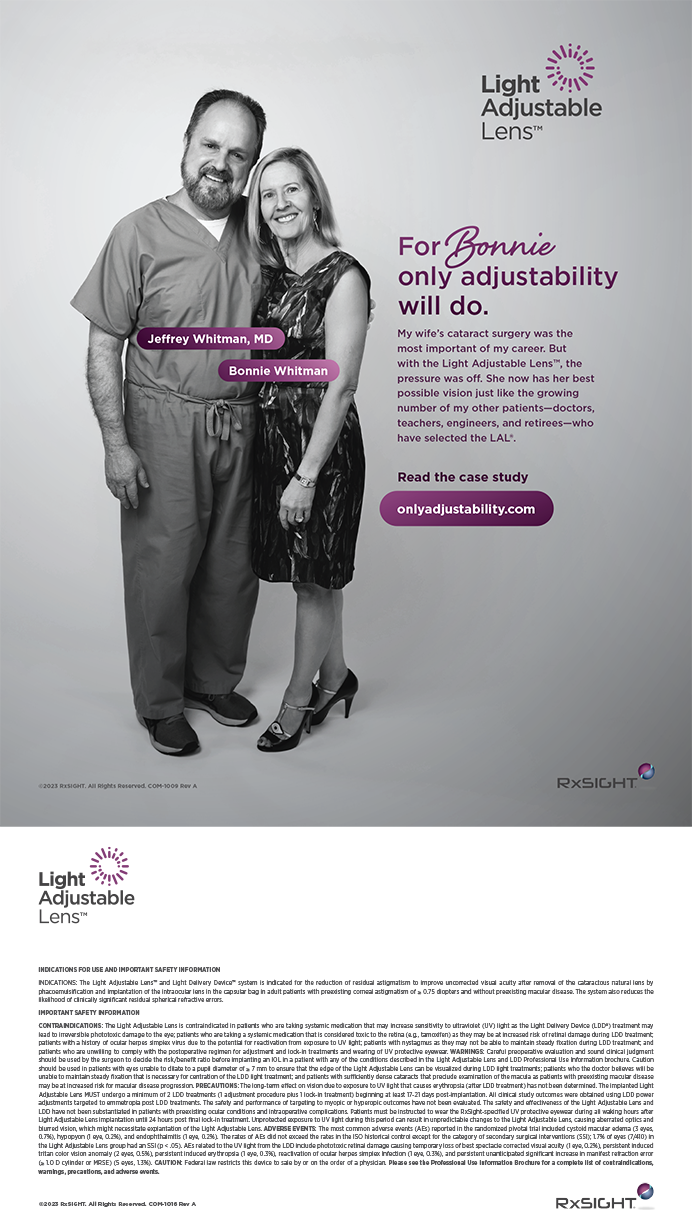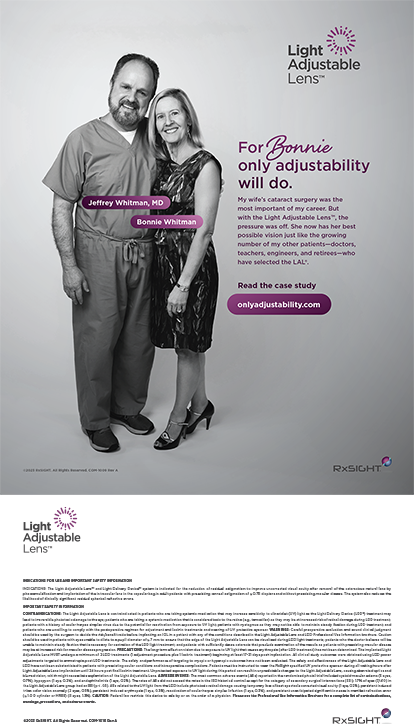With the increasing popularity and expanding applications of femtosecond lasers in ophthalmology,1,2 refractive surgery in particular, a common question among practitioners is, how do the platforms differ? Currently commercially available in the United States are the IntraLase FS (Advanced Medical Optics, Inc., Santa Ana, CA), Femto LDV (Ziemer Ophthalmic Systems Group, Port, Switzerland), Femtec (20/10 Perfect Vision AG, Heidelberg, Germany), and VisuMax femtosecond laser system (Carl Zeiss Meditec, Inc., Dublin, CA). A meaningful comparison requires some basic concepts of femtosecond laser physics and tissue interactions,3-5 important aspects of which are reviewed in this article.
BASIC PRINCIPLES
How short is ultrashort? The definition of a femtosecond is 10-15 seconds (ie, one millionth of a billionth of a second). Putting that information into comprehensible terms, it takes 1.2 seconds for light to travel from the moon to an earthbound observer's retinas. In 100 femtoseconds, light traverses 30 ?m—around one-third the thickness of a human hair. During that time, laser pulses can carry energies of some nano- to microJoules, which leads to peak power equivalent to that produced at nuclear power plants (mega- to gigawatts).
Most ophthalmologists are familiar with the linear absorption of light energy, which leads to the process known as photoablation that is produced by excimer lasers. Femtosecond lasers produce a different tissue interaction, however, known as photodisruption (Figure 1). The application of many photons of laser energy at the same place and time leads to a nonlinear absorption of femtosecond laser energy. Due to the multiphoton effect, as well as the electron avalanche phenomenon, energy absorption by tissue eventually exceeds the threshold for optical breakdown. This process of photodisruption creates plasma. It also produces an acoustic shockwave, some thermal energy, and then a cavitation bubble, which expands at supersonic speed, slows down, and then implodes. A gas bubble subsequently forms that is composed of carbon dioxide, water, nitrogen, and other elements.
The effect of photodisruption on tissue varies as infrared laser energy decreases from the level of micro- to nanoJoules (Figure 2). Nd:YAG lasers are used to produce posterior capsulotomies at milliJoule energies (10-nanosecond pulse duration). Femtosecond lasers can cut LASIK flaps at microJoule energy (approximately 930-femtosecond pulse duration), LASIK flaps almost without bubbles at 100 nanoJoules (200-femtosecond pulse duration), and chromosome cutting with femtoscissors at 1 nanoJoule (90-femtosecond pulse duration) with a lens that has a very high numerical aperture.
The threshold for optical breakdown (photodisruption) is inversely related to the laser's intensity. The shorter the pulse's duration and the smaller the diameter (and volume) of the spot, the lower the energy needed for photodisruption. A lens with a higher numerical aperture will create a more focal laser spot in terms of its diameter and volume, which enhances the depth accuracy and overall precision of the lamellar cut. This strategy of a higher numerical aperture lens is employed by the Ziemer and Visumax systems. Lower pulse energy is generally associated with fewer unwanted side effects, such as an opaque bubble layer, collateral thermal damage, and possibly diffuse lamellar keratitis as well as transient light sensitivity.
BASIC DIFFERENCES
There are two basic paradigms in the photodisruptive process. One employs high-energy (microJoule) pulses and a low-frequency pulse engine (kHz). The other relies on low-energy (nanoJoule), high-frequency (MHz) pulses. The current IntraLase FS and Femtec systems use higher-energy, lower-frequency pulses than the Femto LDV laser. The VisuMax falls somewhere in the middle.
Higher-energy pulses allow greater spacing between spots, because the expanding gas bubbles drive the cutting process (Figure 3). Because overly wide spacing can result in uncut areas or bridges of tissue, surgeons must factor both energy and spacing into the treatment plan. Lower-energy pulses and smaller spot sizes and volumes require the use of substantially more spots placed closer together, because the plasma itself is the primary driver of the cutting process. To deliver this many spots in a reasonable timeframe requires a very-high-frequency engine. Although the energy per pulse is lower (nanoJoule vs microJoule range), the total energy delivered to the cornea is actually higher, reflecting the far greater total number of pulses. Because this energy delivery is dispersed over time and space, however, the thermal effect on the cornea is minimal (~D2°C, which is less thermal change than with eye closure), and the precise placement in the z-plane obviates the delivery of laser energy to proximal ocular tissues.
DIFFERENTIATING FEATURES
Table 1 outlines some of the major differences between the commercially available femtosecond lasers for refractive surgery. The Femto LDV is the only mobile unit, and, like the VisuMax, it is less sensitive than the other lasers to environmental variations such as in temperature and humidity. The Femto LDV system is smaller and has a faster startup than the Femtec or IntraLase FS, in part because it utilizes an industrial laser head based on the concept of an oscillator rather than an amplifier. The unit's articulating arm fits under the excimer laser (similar to a mechanical microkeratome), which obviates the need to move the patient or the bed (although this may be required under the Visx Star S4 Laser System [Advanced Medical Optics, Inc.]).
A comparative disadvantage of the Femto LDV unit is that, as with a mechanical microkeratome, surgeons cannot visualize the cornea during the flap's creation, although they can halt the process and move the prism to view the progress of the midcut. The unit also has the fewest programmable features (such as the flap's diameter, centration, hinge, and side-cut angle). Although it can produce a larger-diameter flap than the IntraLase FS, the current Femto LDV is the only femtosecond laser system that does not create a vertical cut (although future iterations may incorporate a servomotor that could accomplish this). Thus, it produces a planar flap with a tapered edge, which may be easier to lift if a retreatment is needed than the "manhole cover" edge or selectable rim angles produced by other femtosecond devices. With the Femto LDV, an optical spacing element called an intershield determines the depth of the cut.
Whereas the IntraLase FS uses manual suction for corneal applanation and the Femto LDV features computer-controlled suction and applanation with glass, the Femtec and VisuMax utilize computer-controlled vacuum and spherical suction interfaces with the cornea. As a result, the Femtec and VisuMax minimize corneal distortion and allow patients to visualize a fixation light throughout the entire procedure. The VisuMax system optically measures the thickness of the various sizes of curved contact interfaces prior to each procedure, in an effort to minimize potential outliers in flap thickness. This technique is performed because variations in optical or physical spacers used in the different femtosecond lasers may still fall within a manufacturer's specifications. Rather than the different raster patterns used by the IntraLase and Femto LDV, the Femtec employs a 3D spiraling laser pattern, which allows any of the opaque bubbles created to move to the periphery and quickly dissipate. The IntraLase permits surgeons to program a pocket to facilitate the egress of the opaque bubble layer, which may interfere with eye tracking by the excimer laser. The lower energy of the VisuMax and Femto LDV systems generally does not create an opaque bubble layer.
EXPANDING APPLICATIONS
Whereas the first-generation Femto LDV functions primarily as a femto-based flap maker, the other units with more programmable features and flexible cutting in the z-plane represent a more versatile corneal workstation. The IntraLase and Femtec have expanded applications, including the creation of tunnels for intrastromal ring segments. The IntraLase has also been used to obtain corneal biopsies in cases of infectious keratitis and to create flaps with edges that resemble a top hat. The latter reportedly facilitate wound healing and minimize postoperative astigmatism after corneal transplantation.6 The VisuMax and Femtec also now have applications in femto-assisted lamellar and penetrating keratoplasty as well as forms of endothelial keratoplasty.
Carl Zeiss Meditec, Inc., pioneered preliminary clinical studies of lenticular extraction with the femtosecond laser. This involves making two lamellar cuts with a femtosecond laser to create an intrastromal lenticle of defined shape, which the surgeon removes. Ophthalmologists have used the VisuMax in this fashion for myopic treatments. They create a huge optical zone and a slightly prolate cornea without any need for the excimer laser ablation of tissue.
Luis A. Ruiz, MD, in Bogotá, Colombia, took this procedure one step further with the Femtec laser. With a single intrastromal ablation, he performed a presbyopic treatment based on the refractive properties as well as the individual biomechanical and geometrical corneal properties predicted by finite element analysis of the cornea.7 Additional (and potentially less invasive) applications of femtosecond lasers for glaucoma and cataract surgery as well as presbyopic lens surgery are likely in the future.
Jay S. Pepose, MD, PhD, is Professor of Clinical Ophthalmology and Visual Sciences at the Washington University School of Medicine, and he is Director of the Pepose Vision Institute in St. Louis. He acknowledged no financial interest in the products or companies mentioned herein. Dr. Pepose may be reached at (636) 728-0111; jpepose@peposevision.com.
Holger Lubatschowski, PhD, is Head of Biomedical Optics Department, Laser Zentrum Hannover e.V., Hannover, Germany. He receives research funds from Ziemer Ophthalmic Systems Group but acknowledged no financial interest in any of the products or other companies mentioned herein. Professor Lubatschowski may be reached at 49 511 2788 279; h.lubatschowski@lzh.de.


